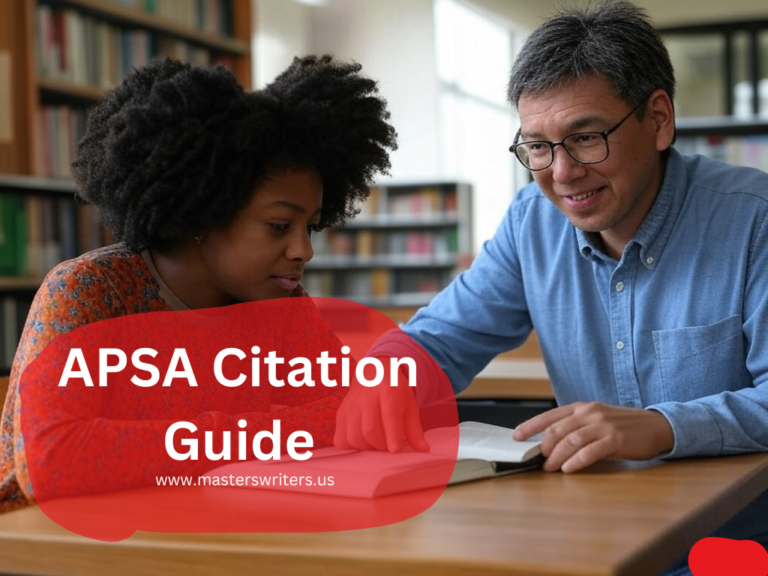Formatting Styles
APSA Citation Guide for Political Science Papers: Best Practices


You’ve put hours into writing your essay—your arguments are strong, your research is well-supported, and everything is shaping up perfectly. But then comes the tricky part: citations. Where do they go? Should the author’s name come first or the year? And what exactly is an in-text citation?
Citing sources isn’t as daunting as it seems. Every time you use someone else’s ideas—whether quoting directly or paraphrasing—you need to provide essential details: the author’s name, the work’s title, and where your reader can find it. These citations appear in two key places:
- Within the text, right where you reference a source. This is called an in-text citation, often enclosed in parentheses.
- At the end of your paper, in a bibliography or reference list, where full details of each source are provided.
If you’re working on a political science paper, you’ll likely need to follow the APSA citation style. Let’s simplify it step by step.
What is APSA Citation Style?
The APSA (American Political Science Association) citation style is a structured referencing system for political science research. Whether submitting an academic paper, writing a thesis, or publishing in an APSA-affiliated journal, this citation style ensures clarity, consistency, and proper source credit.
Here’s a breakdown of the essentials:
- In-text citations (parenthetical style): APSA uses brief in-text references that direct readers to full source details in the reference list. For example, (Jones 2021, 78) includes the author’s last name, publication year, and page number.
- Page numbers are crucial: If you’re quoting directly, page numbers are required. Even for paraphrased content, including them is highly recommended to enhance accuracy and credibility.
- Clear and concise formatting: APSA prioritizes simplicity and readability—no complicated citation structures, just a professional and streamlined approach to referencing sources.
The APSA style was developed to standardize political science writing, ensuring that research is well-documented and easy to follow. Using this system correctly helps you maintain academic integrity and allows readers to trace your sources effortlessly.
APSA Citation General Rules
Citing sources may not be the most exciting part of writing, but it’s a crucial skill for any student or researcher. The APSA (American Political Science Association) citation format is a standardized system that ensures clarity and consistency in political science writing. Once you grasp the basics, citing sources becomes second nature.
In-Text Citations
APSA follows a parenthetical citation format, meaning brief references appear within the text, pointing readers to complete details in the reference list. These citations provide just enough information to locate the source without interrupting the flow of your writing.
Here’s how APSA in-text citations work:
- Basic format: Include the author’s last name and publication year in parentheses: (Garcia 2022).
- Direct quotes: If quoting directly, add a page number after a comma: (Garcia 2022, 112).
- No publication date: Use n.d. (no date) if the year is unavailable: (Harrison n.d.).
Citing Multiple Authors or Sources
Different rules apply when citing multiple authors or multiple sources in one citation:
- Two authors: List both names, joined by “and”: (Nguyen and Patel 2021).
- Three or more authors: List only the first author, followed by et al. (Jensen et al. 2019, 67).
- Multiple works by the same author in the same year: Differentiate them using letters: (Chen 2020a, 45) and (Chen 2020b).
- No author: Use the title instead, italicizing books and placing article titles in quotation marks: (“Economic Trends in Asia” 2021).
- Citing multiple sources in one reference: Separate them with semicolons: (Lewis 2018; Carter and Hill 2019; Adams 2020, 87).
Mastering these general rules makes using APSA citations much easier, helping you maintain academic integrity while keeping your research well-organized.
APSA Reference List
The APSA reference list is where you provide complete details for every source cited in your paper. This section ensures readers can locate the sources used in your research. To maintain consistency and clarity, follow these key formatting rules:
- Alphabetize by the author’s last name—if no author is listed, use the title for ordering.
- Use a hanging indent—the first line of each entry is left-aligned, while subsequent lines are indented.
- Follow APSA formatting precisely—ensure correct punctuation, italics, and spacing.
Examples of APSA Citations by Source Type
- Books: Italicize the title.
- Example:
- Watson, Emily. 2015. Political Ideologies in the 21st Century. Chicago: University Press.
- Example:
- Journal Articles: Place the article title in quotation marks, but italicize the journal name.
- Example:
- Chen, Robert. 2018. “The Evolution of Global Governance Structures.” Journal of Political Studies 52 (4): 312–330.
- Example:
- Chapters in Edited Books: Italicize the book title while keeping the chapter title in quotation marks.
- Example:
- Martinez, Carlos. 2007. “The Impact of Social Movements.” In Democracy in Action, edited by Linda Baker, 88–105. London: Oxford University Press.
- Example:
- Online Sources: Include the URL and access date (if required).
- Example:
- “International Policy Shifts.” 2022. Accessed March 10, 2024. https://www.intpolicyshifts.com.
- Example:
- Multiple Authors: List all authors in the reference list. Use “et al.” for in-text citations if there are four or more authors.
- Example:
- Jackson, Sarah, Michael Lee, and Olivia White. 2019. Public Opinion and Policy Change. New York: HarperCollins.
- Example:
Notes and Footnotes
In APSA citation style, notes and footnotes provide extra information that doesn’t fit neatly into the main text but is still relevant. These are not used for regular citations (which belong in the in-text citations and reference list) but are perfect for providing context, additional explanations, or background details.
Types of Notes in APSA
- Footnotes – Appear at the bottom of the page where the superscript number is placed in your text. These are useful for brief clarifications or additional references.
- Endnotes – Gather all notes in one section at the end of the document. These work best for more detailed commentary without cluttering the main text.
How to Format Notes in APSA
To include a note in APSA style, follow these guidelines:
- Insert a superscript number in your text to indicate the note’s location:
*The policy shift reflects a growing trend in international relations.*¹ - Provide the corresponding note at the bottom of the page (footnote) or in the endnotes section:
¹ Garcia, Lisa. Global Political Strategies. London: Cambridge Press, 2021. - Keep formatting consistent with APSA guidelines and use notes only when they add value.
Citing Different Types of Sources
Not all sources fit neatly into the category of books or journal articles. Thankfully, the APSA citation style provides clear guidelines for citing various materials, from government documents to legal cases, interviews, and websites. Below are examples of how to cite different types of sources correctly.
- Government Documents
When citing a government document, the agency or department is listed as the author.
✅ In-text citation:
(CDC 2021, 15).
✅ Reference list entry:
CDC. 2021. Annual Report on Public Health Initiatives. New York: Government Printing Office.
- Legal Cases
Legal cases should be cited using the case name and the year.
✅ In-text citation:
(Brown v. Board of Education 1954).
✅ Reference list entry:
Brown v. Board of Education, 347 U.S. 483 (1954).
- Interviews
For personal interviews, include the interviewee’s name, interviewer (if applicable), and date.
✅ In-text citation:
(Harrison 2022).
✅ Reference list entry:
Harrison, Maria. 2022. Interview by David Langston. June 10. Toronto.
📌 Note: Personal interviews are usually cited only in the text and not in the reference list unless publicly available.
- Websites
For web sources, include the full URL and access date if no publication date is available.
✅ In-text citation:
(World Bank 2023).
✅ Reference list entry:
World Bank. 2023. “Global Economic Forecasts.” Accessed February 12, 2024. https://www.worldbank.org/global-forecasts.
- Reports
Reports are cited similarly to books, but the organization acts as the author.
✅ In-text citation:
(United Nations 2020, 43).
✅ Reference list entry:
United Nations. 2020. Global Climate Change Report. Geneva: United Nations Publications.
Legal Citations
Legal citations include the case name, year, and legal reference details.
✅ In-text citation:
(Miranda v. Arizona 1966).
✅ Reference list entry:
Miranda v. Arizona, 384 U.S. 436 (1966).
Common APSA Citation Mistakes
When using the APSA citation style, minor errors can impact the credibility and clarity of your work. Below are some of the most frequent mistakes and how to correct them.
❌ Mistake | ⚠️ Explanation | ✅ Example |
🔍 Missing Author Name | Always include the author’s last name in in-text citations and their full name in the reference list. | Incorrect: (2021) |
📅 Wrong Publication Year | Double-check the publication year to ensure accuracy. Incorrect years can mislead readers. | Incorrect: (Garcia 2018) |
📄 Omitting Page Numbers for Quotes | Always include a page number when citing a direct quote. | Incorrect: (Nguyen 2022) |
✍️ Inconsistent Formatting | Use italics for book titles and quotation marks for article titles. | Incorrect: Taylor, Mark. 2019. “Political Reform Strategies.” Washington, DC: Policy Press. |
👥 Improper Use of ‘et al.’ | Use ‘et al.’ for in-text citations when there are four or more authors, but list all names in the reference list. | Incorrect: (Lopez, Kim, and Patel 2021) |
🔤 Misordering Multiple Citations | List multiple sources alphabetically by the first author’s last name within a single citation. | Incorrect: (Williams 2021; Brown 2019) |
By avoiding these common APSA mistakes, you’ll ensure that your citations are accurate, professional, and easy to follow, strengthening the credibility of your academic work.
Once your citations are done, let an experienced essay editor give your paper the final touch it needs.
APSA Citation Simplified
Citing sources doesn’t have to be overwhelming! With APSA style, the key is simplicity and consistency. By following the guidelines, avoiding common mistakes, and keeping your references well-organized, you’ll ensure that your citations enhance the credibility of your work rather than cause unnecessary stress.
It’s time to wrap up that essay—you’ve got this! If citations still feel challenging, consider seeking expert writing assistance to ensure your references are perfectly formatted while you focus on writing a strong argument.

Simplify Your Citations
Stop stressing over formatting your references. Let our experts take care of it, so you can concentrate on what matters most—your writing.
FAQs
How Do You Cite in APSA?
In APSA citation style, sources are cited using parenthetical in-text citations and a reference list at the end of the paper.
In-text citation format:
(Author Last Name Year, Page Number)
Example:
(Johnson 2021, 45)
At the end of the paper, include a full citation in the reference list:
Reference list format for a book:
Johnson, Emily. 2021. Politics in the Digital Age. New York: Oxford University Press.
How to Cite APSA With Multiple Authors?
When citing a source with multiple authors in APSA style, follow these rules:
- Two authors: Include both names with “and”
(Smith and Patel 2020, 78) - Three or more authors: Use et al. after the first author’s name
(Garcia et al. 2022, 15)
Reference list example for multiple authors:
Smith, John, and Lisa Patel. 2020. Government Policies and Economic Growth. Washington, DC: Policy Press.
Garcia, Robert, Mark Lee, and Susan Jones. 2022. Global Political Trends. London: Cambridge University Press.
What Is a Parenthetical Citation Example?
A parenthetical citation in APSA style is a short in-text citation enclosed in parentheses, providing key details about the source.
Basic format: (Author Last Name Year, Page Number)
Example: (Taylor 2019, 34)
If the citation has no page number, include the author’s last name and year:
(Williams 2020)
If citing multiple sources in the same parentheses, separate them with semicolons:
(Clark 2018; Johnson 2021, 50; Lee 2019)
Sources
High Point University (2021). APSA (American Political Science Association) Citation Guide. HPU. https://guides.highpoint.edu/apsa

